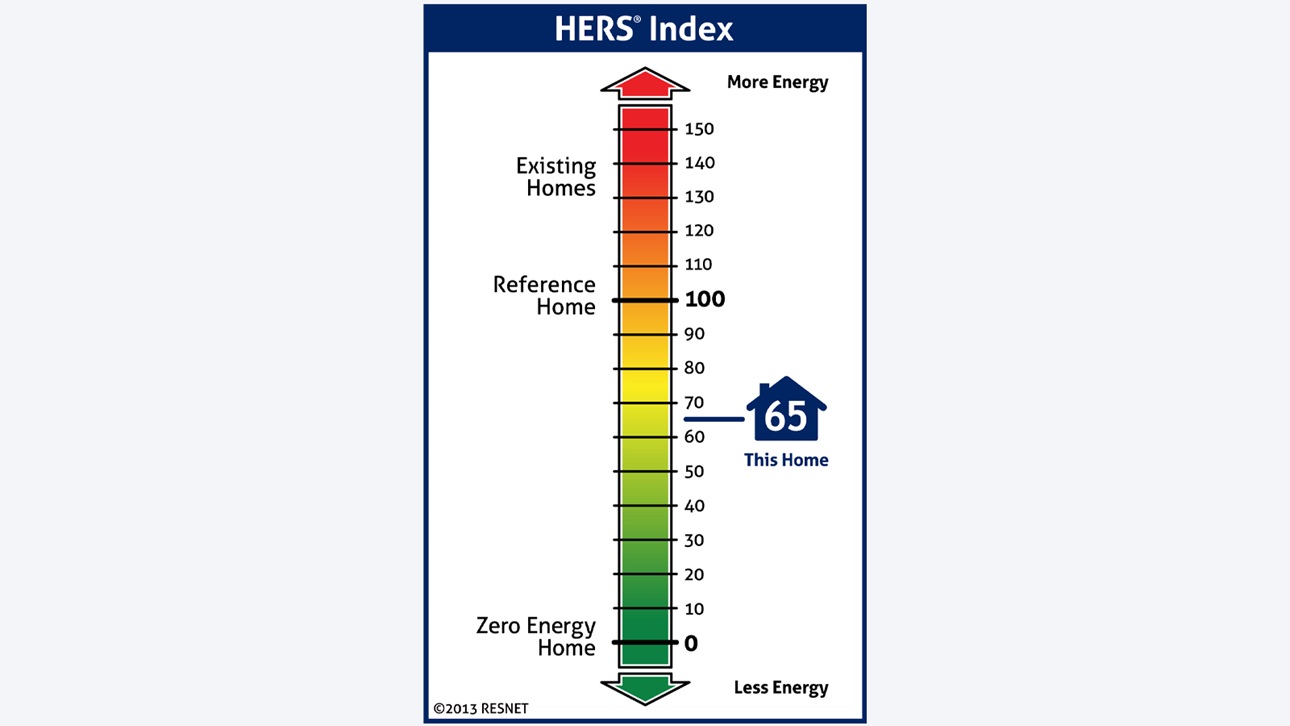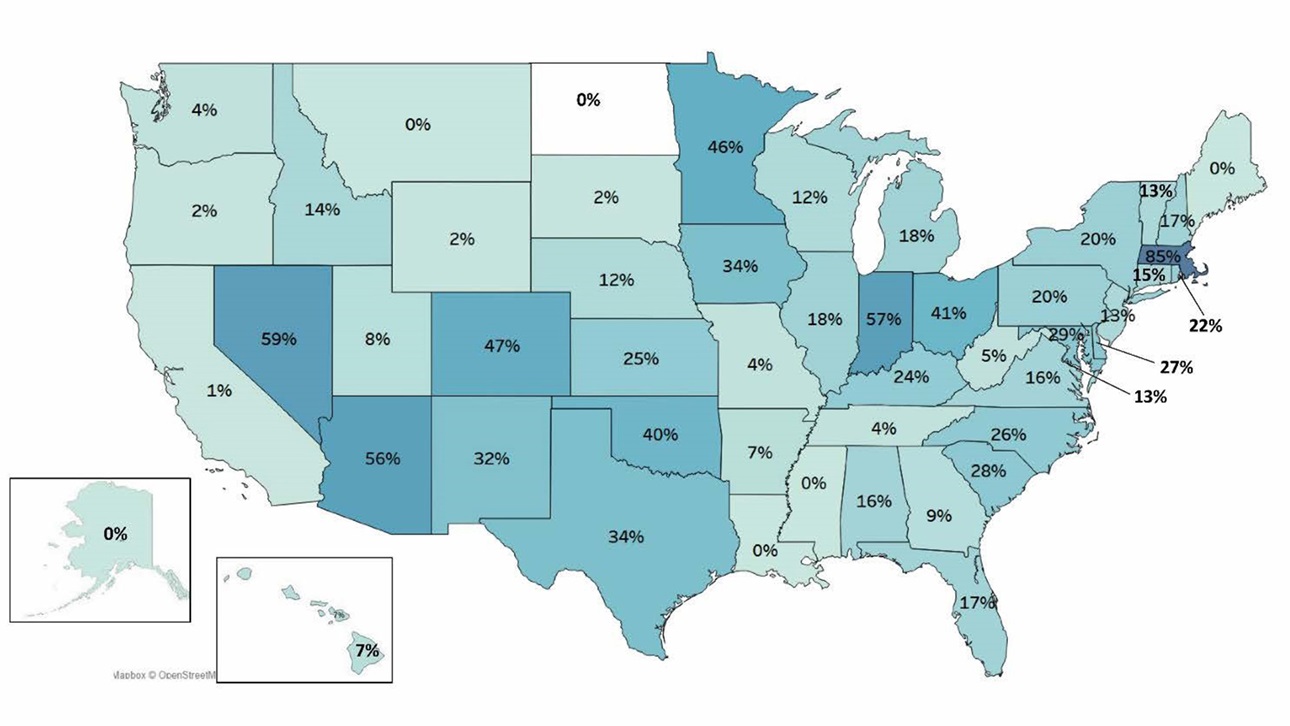Nearly 1 in 4 New Homes Received HERS Rating in 2020

A home’s Home Energy Rating System (HERS) Index Score is calculated by a certified Residential Energy Services Network (RESNET) HERS Rater who provides an energy rating for a home by comparing its features against a defined reference home, which has a set score of 100. For example, a home with a HERS Index Score of 70 is 30% more energy efficient than the reference home (a 2006 standard built home).
Since the inception of the HERS Index in 1995, there have been more than 3.2 million HERS-rated homes, with more than 230,000 homes rated this year. 2020 saw a 24% increase in number of rated homes over 2019, with nearly one in four new homes built receiving a HERS Index Score, according to RESNET.
“Home builders are increasingly seeing energy efficiency as a major selling point for buying a new home,” says RESNET Executive Director Steve Baden. “It is particularly encouraging that the average HERS Index Score of homes HERS rated [in 2020] was 58. This is 42% more efficient than homes built as recently as 2006 and 72% more efficient than a typical home built in the 1970s.”
ENERGY STAR and DOE Zero Energy Ready Homes (ZERH) that provided solar started out slightly more efficient, with an average HERS Index Score of 56, which improved to an average of 28 once the impact of the solar panels was included.
The program can be used in all climate zones for single-family, duplex and low-rise multifamily projects. On average in any given year, about 75% of rated homes are single-family homes or duplexes. New and existing projects can use the program, although current rated homes are overwhelmingly (more than 90%) new construction.
The top 10 states for number of HERS-rated homes in 2020 are shown in the table, along with the percentage of new homes that were HERS rated in that state. The map illustrates the market penetration of new HERS-rated homes in 2020 across the United States. In some markets, a HERS Index Score is becoming the norm of doing business; in others, it is still a differentiator.
Top 10 States in 2020
| State | Number of HERS-Rated Homes | Average HERS Index Score | Percentage of 2020 New Homes HERS Rated |
| Texas | 65,081 | 58 | 40% |
| Florida | 23,750 | 55 | 17% |
| Arizona | 20,966 | 55 | 47% |
| North Carolina | 20,622 | 63 | 27% |
| Colorado | 16,696 | 57 | 42% |
| South Carolina | 11,880 | 60 | 29% |
| Virginia | 11,160 | 62 | 23% |
| Indiana | 11,144 | 64 | 54% |
| Ohio | 10,501 | 60 | 45% |
| Massachusetts | 9,922 | 51 | 87% |
Source: Ryan Meres, RESNET

To find out if a home has been HERS rated by a certified HERS Rater and its confirmed HERS Index Score, visit RESNET’s portal.
Learn how to obtain a HERS Index Score for your next build.
To stay current on the high-performance residential building sector, with tips on water efficiency, energy efficiency, indoor air quality, and other building science strategies, follow NAHB’s Sustainability and Green Building efforts on Twitter.
Latest from NAHBNow
Dec 19, 2025
2025 Census Survey Reminder: Help Us Advocate for Home BuildingMembers should have received an important reminder this week from NAHB to complete our 2025 Builder and Associate Member Census. Please take a few minutes to participate to help us develop education, advocacy and networking opportunities needed to help your business grow.
Dec 19, 2025
Ford Announces Big Savings for NAHB Members on 2026 Model Year VehiclesAs a flagship partner of the NAHB Member Savings Program, Ford Pro has announced significant savings on eligible 2026 model year vehicles — up to $5,500 off. The lineup includes popular options such as Broncos, F-150s, Super Duty pickups, and Transit vans.
Latest Economic News
Dec 19, 2025
Existing Home Sales Edge Higher in NovemberExisting home sales rose for the third consecutive month in November as lower mortgage rates continued to boost home sales, according to the National Association of Realtors (NAR). However, the increase remained modest as mortgage rates still stayed above 6% while down from recent highs. The weakening job market also weighed on buyer activity.
Dec 18, 2025
Lumber Capacity Lower Midway Through 2025Sawmill production has remained essentially flat over the past two years, according to the Federal Reserve G.17 Industrial Production report. This most recent data release contained an annual revision, which resulted in higher estimates for both production and capacity in U.S. sawmills.
Dec 18, 2025
Inflation Slows in November (with a Caveat)Inflation unexpectedly eased in November, according to the Bureau of Labor Statistics (BLS) latest report. This data release was originally scheduled for December 10 but was delayed due to the recent government shutdown.
